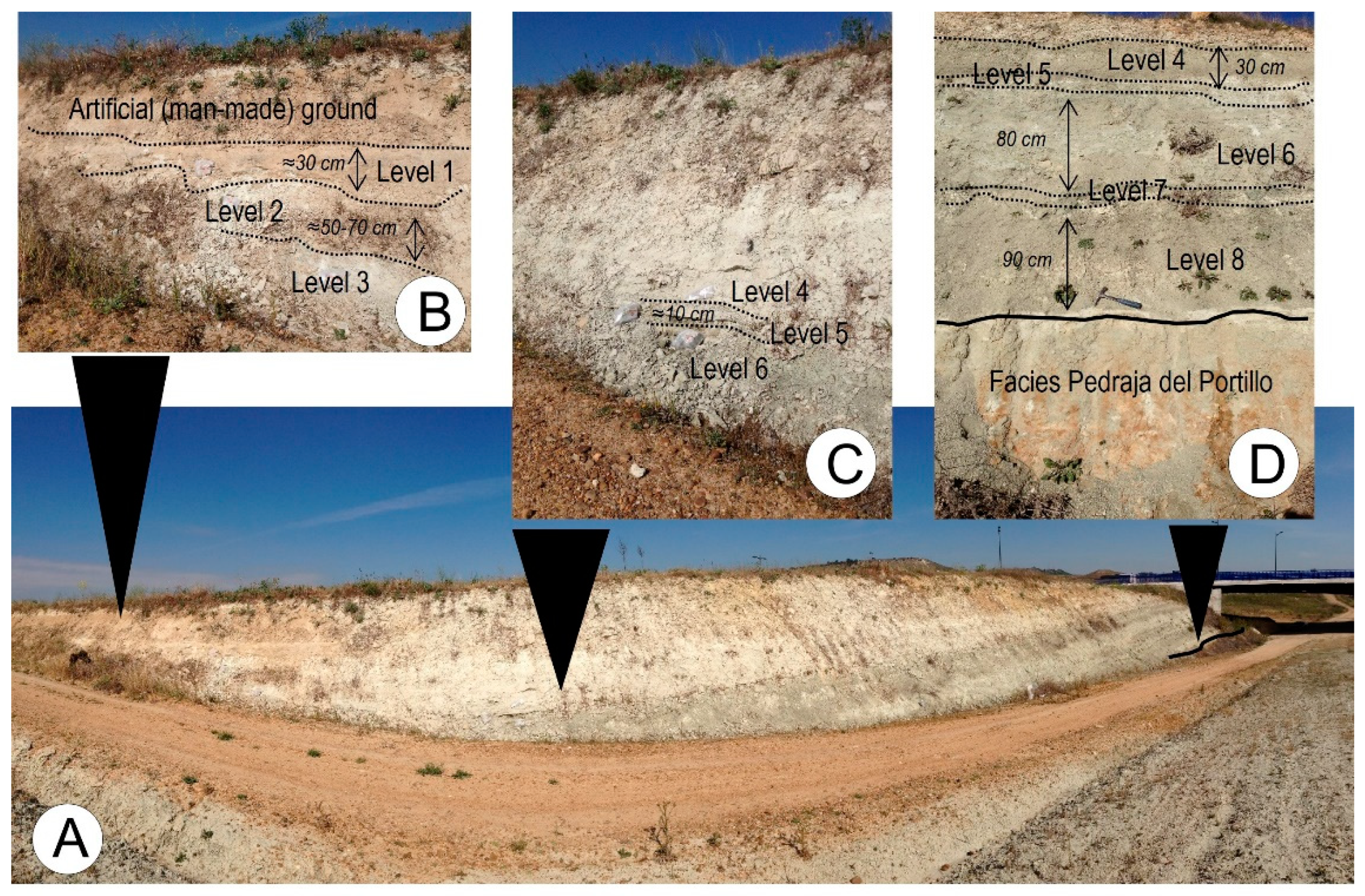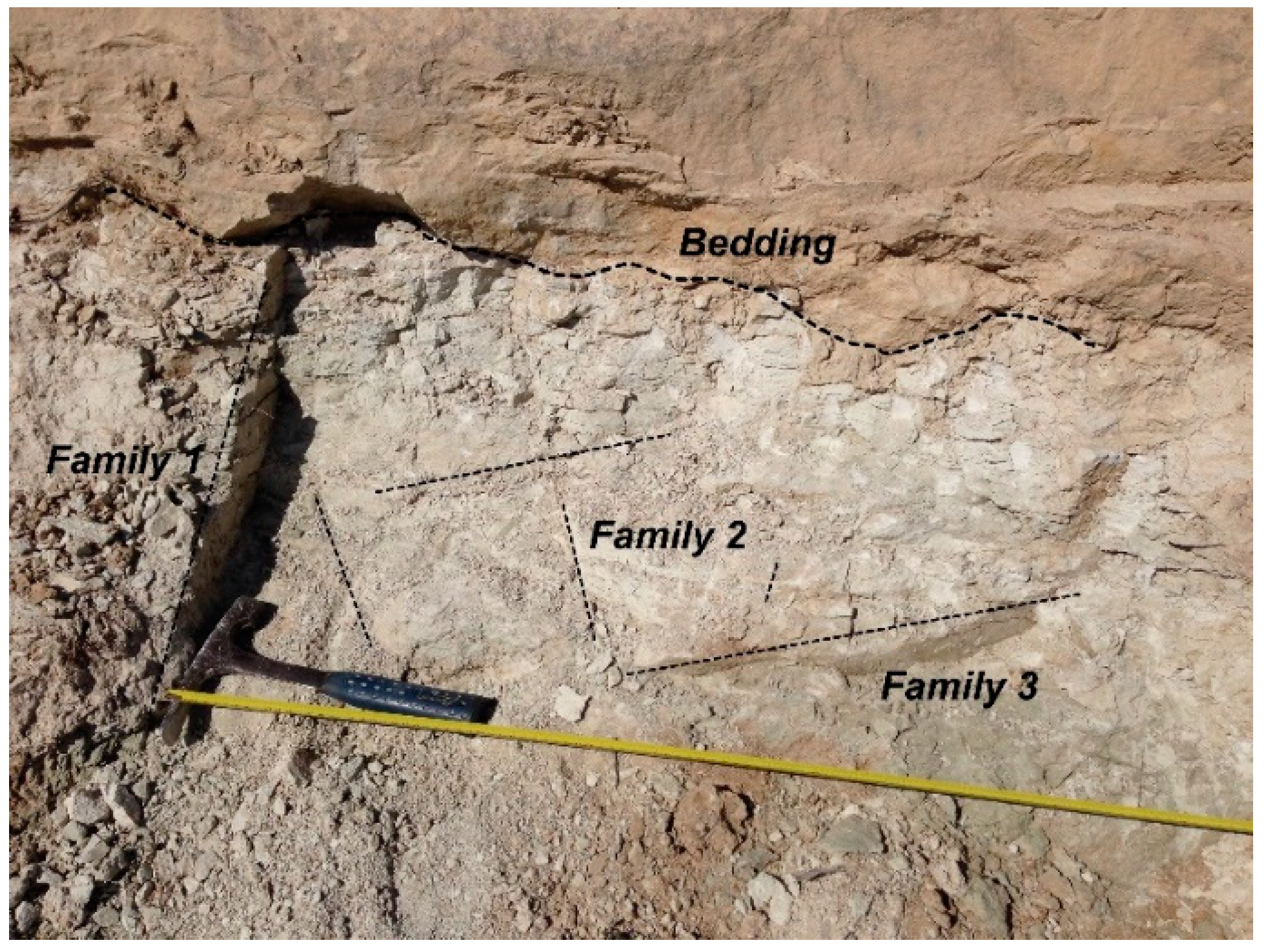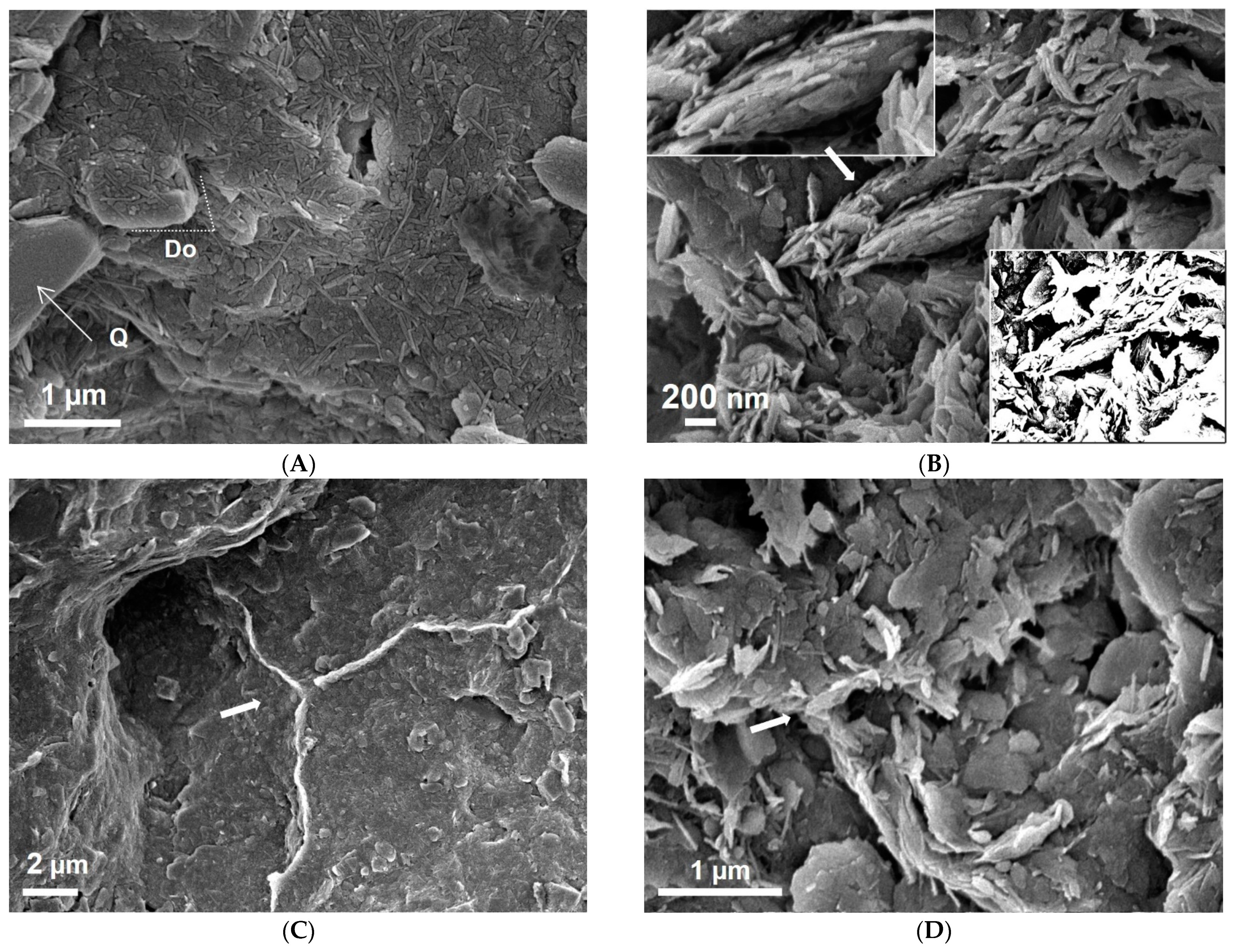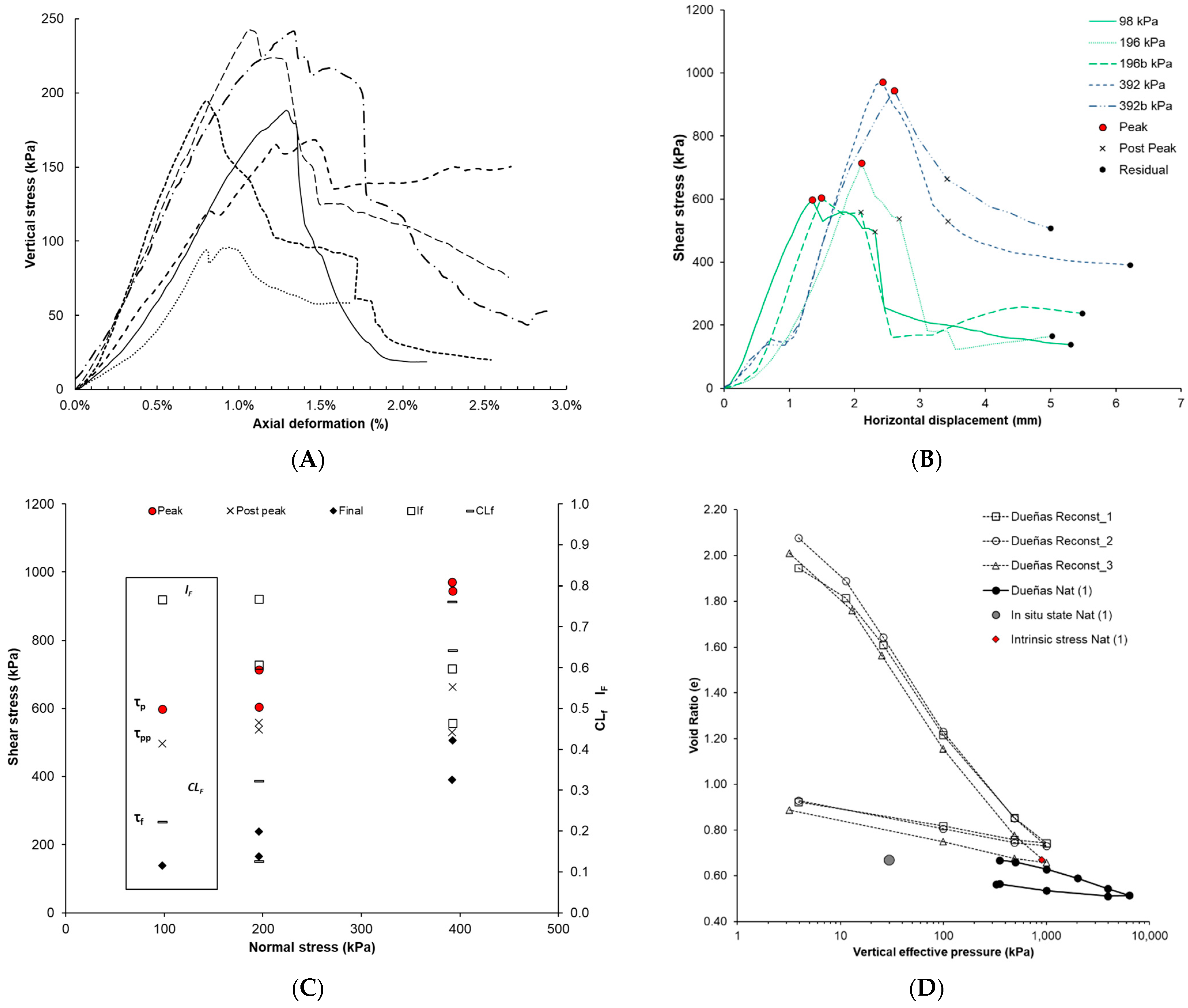Structure and Mechanical Properties of the Dueñas Clay Formation (Tertiary Duero Basin, Spain): An Overconsolidated Clay of Lacustrine Origin
Abstract
:1. Introduction
2. Geological Setting
3. Materials and Methods
4. Results
4.1. Description and Mineralogy
4.2. Structure
4.2.1. Macrostructure
4.2.2. Microstructure
- Feldspathic arenite (level 1, level 2, level 4, and level 5)
- Sandy carbonated lutite (level 3)
- Clay (level 6 and level 8)
- Silicate sand (level 7)
4.3. Density, Carbonate Content, Durability and Rock Strength
4.4. The Clay Levels of the Dueñas Formation
4.4.1. Identification Properties
4.4.2. Strength
4.4.3. Compressibility
5. Discussion
- The role of the carbonate content
- Macrostructure
- Microstructure
- Preconsolidation pressure
- Intrinsic versus natural compression curves—the sensitivity framework
- On the strength of the COC
6. Conclusions
Author Contributions
Funding
Institutional Review Board Statement
Conflicts of Interest
References
- Bilotta, E.; Stallebrass, S.E. Prediction of Stresses and Strains around Model Tunnels with Adjacent Embedded Walls in Overconsolidated Clay. Comput. Geotech. 2009, 36, 1049–1057. [Google Scholar] [CrossRef] [Green Version]
- Fernández, J.M.G.; Checa, M.; Pérez, C.; Williams, B.; Pozo, V. Caracterización de Detalle de de Las Margas Azules Del Guadalquivir Mediante Ensayos in Situ y de Laboratorio. Ingeopres Actual. Técnica Ing. Civ. Min. Geol. Medio Ambiente 2009, 186, 16–22. [Google Scholar]
- Tsige, M. Microfábrica y Mineralogía de Las Arcillas Azules Del Guadalquivir: Influencia En Su Comportamiento Geotécnico; Centro de Estudios y Experimentación de Obras: Madrid, Spain, 1999; ISBN 9788449804267. [Google Scholar]
- Pusch, R. Experience from Preparation and Investigation of Clay Microstructure. Eng. Geol. 1999, 54, 187–194. [Google Scholar] [CrossRef]
- Stallebrass, S.E.; Atkinson, J.H.; Mašín, D. Manufacture of Samples of Overconsolidated Clay by Laboratory Sedimentation. Géotechnique 2007, 57, 249–253. [Google Scholar] [CrossRef]
- Gasparre, A. Advanced Laboratory Characterisation of London Clay. Ph.D. Thesis, Imperial College London, London, UK, 2005. [Google Scholar]
- Gasparre, A.; Nishimura, S.; Coop, M.R.; Jardine, R.J. The influence of structure on the behaviour of London Clay. Géotechnique 2007, 57, 19–31. [Google Scholar] [CrossRef]
- Amorosi, A.; Rampello, S. An experimental investigation into the mechanical behaviour of a structured stiff clay. Géotechnique 2007, 57, 153–166. [Google Scholar] [CrossRef]
- Santagata, M.; Kang, Y.I. Effects of Geologic Time on the Initial Stiffness of Clays. Eng. Geol. 2007, 89, 98–111. [Google Scholar] [CrossRef]
- Wilkinson, S.; Fenton, C. The Application of Stereo E-SEM in Understanding 3D Mudrock Structure. In Proceedings of the 11th IAEG Congress, Auckland, New Zealand, 10–14 September 2010; pp. 5–10. [Google Scholar]
- Sorensen, K.K.; Baudet, B.A.; Simpson, B. Influence of Structure on the Time-Dependent Behaviour of a Stiff Sedimentary Clay. Géotechnique 2007, 57, 113–124. [Google Scholar] [CrossRef] [Green Version]
- Burland, J.B.; Rampello, S.; Georgiannou, V.N.; Calabresi, G. A Laboratory Study of the Strength of Four Stiff Clays. Géotechnique 1996, 46, 491–514. [Google Scholar] [CrossRef]
- Burghignoli, A.; Miliziano, S.; Soccodato, F.M. Cementation Effects in Two Lacustrine Clayey Soils. Geotech. Geol. Eng. 2010, 28, 815–833. [Google Scholar] [CrossRef]
- Burland, J.B. On the Compressibility and Shear Strength of Natural Clays. Géotechnique 1990, 40, 329–378. [Google Scholar] [CrossRef]
- Chandler, R.J. The Third Glossop Lecture Clay Sediments in Depositional Basins: The Geotechnical Cycle. Q. J. Eng. Geol. Hydrogeol. 2000, 33, 7–39. [Google Scholar] [CrossRef]
- Chandler, R.J.; Cotecchia, F. A General Framework for the Mechanical Behaviour of Clays. Géotechnique 2000, 50, 431–447. [Google Scholar]
- Escolano, F.; Bueno, M. Analysis of a Dilatometer Test in Over-Consolidated Sediments, Basin of the Duero River, Spain. Acta Geotech. Slov. 2015, 12, 37–47. [Google Scholar]
- Armenteros, I.; Corrochano, A.; Alonso-Gavilán, G.; Carballeira, J.; Rodríguez, J.; Armenteros, I.; Corrochano, A.; Alonso, G.G.; Carballeira, J.; Rodríguez, J.M. Geology of Spain; Gibbons, W., Moreno, M., Eds.; Geological Society of London: London, UK, 2002; pp. 309–315. ISBN 9781862391277. [Google Scholar]
- Torrero, C.; Nespereira, J.; Yenes, M.; Monterrubio, S. Modelling the Behaviour of Stiff Clays from Continental Origin in Tunnel Construction: Back Analysis of the First Stage of the El Almendro Tunnel. In Proceedings of the 17th European Conference on Soil Mechanics and Geotechnical Engineering, ECSMGE 2019–Proceedings, Reykjavík, Iceland, 1–6 September 2019. [Google Scholar]
- IAEG. Rock and Soil Description and Classification for Engineering Geological Mapping. Bull. Int. Assoc. Eng. Geol. 1981, 24, 235–274. [Google Scholar] [CrossRef]
- Belokas, G.; Kavvadas, M. An Intrinsic Compressibility Framework for Clayey Soils Position of ICC p Mean or Isotropic Effective Stress. Geotech. Geol. Eng. 2011, 29, 855–871. [Google Scholar] [CrossRef]
- Alonso-Gavilán, G.; Armenteros, I.; Carballeira, J.; Corrochano, A.; Huerta, P.; Rodríguez, J. Cuenca del Duero. In Geología de España; Vera, J., Ed.; Sociedad Geológica de España-Instituto Geológico y Minero de España: Madrid, Spain, 2004; pp. 550–555. [Google Scholar]
- Hallsworth, C.; Knox, R. BGS Rock Classification Scheme. Volume 3, Classification of Sediments and Sedimentary Rocks; British Geological Survey: Nottingham, UK, 1999. [Google Scholar]
- Bullock, P.; Fedroroff, N.; Jongerius, A. Handbook for Soil Thin Section Description; Waine Research Publications: Albrighton, UK, 1985; ISBN 9780905184098. [Google Scholar]
- Mitchell, J. Fundamentals of Soil Behaviour; John Wiley & Sons: Hoboken, NJ, USA, 1976; ISBN 9780471463023. [Google Scholar]
- Wilkinson, S.; Fenton, C. The Influence of Geological History on Preferred Particle Orientation and the Observed Anisotropy of Over Consolidated UK Mudrocks. In Proceedings of the Engineering Geology for Society and Territory, Torino, Italy, 15–19 September 2014; Lollino, G., Giordan, D., Thuro, K., Carranza-Torres, C., Wu, F., Marinos, P., Delgado, C., Eds.; Springer International Publishing: Cham, Switzerland, 2015; Volume 6, pp. 805–808. [Google Scholar]
- González de Vallejo, L.; Ferrer, M.; Ortuño, L.; Oteo, C. Ingeniería Geológica; Pearson Education: London, UK, 2002; ISBN 8420531049. [Google Scholar]
- AENOR. Standard Test Methods for Geotechnical Tests (Soils); Spanish Association of Standardization and Certification: Madrid, Spain, 1999. [Google Scholar]
- Wood, L.E.; Deo, P. A Suggested System for Classifying Shale Materials for Embankments. Bull. Assoc. Eng. Geol. 1975, 12, 39–55. [Google Scholar]
- Lutton, R.J. Slaking Indexes for Design; United States Federal Highway Administration Offices of Research & Development: McLean, VA, USA, 1977. [Google Scholar]
- Miščević, P.; Vlastelica, G. Durability Characterization of Marls from the Region of Dalmatia, Croatia. Geotech. Geol. Eng. 2011, 29, 771–781. [Google Scholar] [CrossRef]
- Vlastelica, G.; Miscevic, P.; Pavic, N. Testing the Shear Strength of Soft Rock at Different Stages of Laboratory Simulated Weathering. J. Croat. Assoc. Civ. Eng. 2017, 68, 955–965. [Google Scholar] [CrossRef] [Green Version]
- Pérez, A.; Elizaga, E. Mapa Geológico de España 1:50,000, hoja n°372 (Valladolid); IGME: Madrid, Spain, 1979. [Google Scholar]
- Yenes, M.; Monterrubio, S.; Nespereira, J.; Santos, G.; Fernández-Macarro, B. Large Landslides Induced by Fluvial Incision in the Cenozoic Duero Basin (Spain). Geomorphology 2015, 246, 263–276. [Google Scholar] [CrossRef]
- Flügel, E. Microfacies of Carbonate Rocks; Springer: Berlin/Heidelberg, Germany, 2004; ISBN 978-3-662-08728-2. [Google Scholar]
- Blanco, J. Procesos de Alteración Meteórica En Series Continentales Arcósicas: Ejemplo Del Paleógeno Del Borde SW de La Cuenca Del Duero. In Proceedings of the Dinámica de las Interacciones Ente Agua y Minerales en Medios de Baja Temperatura (Meteorización, Diagénesis, Metasomatismo), Salamanca, Spain, 28 September 1999. [Google Scholar]
- Garcia-Romero, E.; Suarez, M. Sepiolite-Palygorskite Polysomatic Series: Oriented Aggregation as a Crystal Growth Mechanism in Natural Environments. Am. Mineral. 2014, 99, 1653–1661. [Google Scholar] [CrossRef] [Green Version]
- Delgado, J.; Del Valle, A. La Geología de La Provincia de Valladolid; Diputación de Valladolid: Valladolid, Spain, 2007. [Google Scholar]
- Takahashi, A.; Fung, D.W.H.; Jardine, R.J. Swelling Effects on Mechanical Behaviour of Natural London Clay. In Proceedings of the 16th International Conference on Soil Mechanics and Geotechnical Engineering, Osaka, Japan, 12–16 September 2005; Volume 16, pp. 443–446. [Google Scholar]
- Armenteros, I.; Corrochano, A. Los Sistemas Lacustres de La Cuenca Terciaria Del Duero. Acata Geol. Hisp. 1989, 24, 259–279. [Google Scholar]
- Armenteros, I. Contribucion al Conocimiento Del Mioceno Lacustre de La Cuenca Terciaria Del Duero Sector Centro-Oriental, Valladolid-Penafiel. Acata Geol. Hisp. 1991, 26, 97–131. [Google Scholar]
- Doval, M.; García Santiago, P.; Domínguez, M.C.; Brell, J. Mineralogía de Las Arcillas de Las Facies Evaporíticas de La Cuenca Del Tajo. Trab. Geol. 1985, 15, 1–8. [Google Scholar]
- De Santiago Buey, C.; Barrios, M.S.; Romero, E.G.; Montoya, M.D. Mg-Rich Smectite “Precursor” Phase in the Tagus Basin, Spain. Clays Clay Miner. 2000, 48, 366–373. [Google Scholar] [CrossRef]
- De Freitas, M.H.; Mannion, A. Biostratigraphy for the London Clay in London. Géotechnique 2007, 57, 91–99. [Google Scholar] [CrossRef]
- Vera Torres, J. Estratigrafía: Principios y Métodos; Rueda: Alcorcón, Spain, 1994; ISBN 9788472070745. [Google Scholar]
- Jones, B.F.; Galan, E. Chapter 16: Sepiolite and Palygorskite. In Hydrous Phyllosilicates; Bailey, S.W., Ed.; Reviews in Mineralogy; Mineralogical Society of America: Washington, DC, USA, 1988; Volume 19, pp. 631–674. ISBN 0-939950-23-5. [Google Scholar]
- Ciantia, M.O.; Castellanza, R.; Crosta, G.B.; Hueckel, T. Effects of Mineral Suspension and Dissolution on Strength and Compressibility of Soft Carbonate Rocks. Eng. Geol. 2015, 184, 1–18. [Google Scholar] [CrossRef]
- Alonso, E.; Gens, A. Aznalcóllar Dam Failure. Part 1: Field Observations and Material Properties. Géotechnique 2006, 56, 165–183. [Google Scholar] [CrossRef] [Green Version]
- Ayala-Carcedo, F.J. La Rotura de La Balsa de Residuos Mineros de Aznalcóllar (España) de 1998 y El Desastre Ecológico Consecuente Del Río Guadiamar: Causas, Efectos y Lecciones. Boletín Geol. Min. 2004, 115, 711–738. [Google Scholar]
- Vitone, C.; Viggiani, G.; Cotecchia, F.; Hall, S.A. Localized Deformation in Intensely Fissured Clays Studied by 2D Digital Image Correlation. Acta Geotech. 2013, 8, 247–263. [Google Scholar] [CrossRef]
- Nunes Veiga, A. Caracterizacao Geotécnica Dos Terrenos Do Vale Tifónico Parceiros-Leiria. Ph.D. Thesis, Universidade de Coimbra, Coimbra, Spain, 2011. [Google Scholar]
- Veiga, A.; Quinta-Ferreira, M. Characterization of the Dagorda Claystone in Leiria, Portugal, Based on Laboratory Tests. In Engineering Geology for Society and Territory–Volume 6; Springer International Publishing: Cham, Switzerland, 2015; pp. 685–688. [Google Scholar]
- Cotecchia, F.; Cafaro, F.; Aresta, B. Structure and Mechanical Response of Sub-Apennine Blue Clays in Relation to Their Geological and Recent Loading History. Géotechnique 2007, 57, 167–180. [Google Scholar] [CrossRef]
- Nespereira, J.; Suárez, M.; Monterrubio, S.; Yenes, M.; Herrera, D. Compresibilidad de Arcillas Sobreconsolidadas de Origen Continental: Estado Reconstituido, Sedimentado y Natural. In Proceedings of the Geo-Temas, Huelva, Spain, 10–14 September 2016; Morales, J.A., Carro, B.M., Miguel, A., Camacho, M.A., Eds.; Geo-Temas: Huelva, Spain, 2016; Volume 1, pp. 957–960. [Google Scholar]
- Portero, J.; Del Olmo, P.; Ramírez del Pozo, J.; Varjas, I. Síntesis Del Terciario Continental de La Cuenca Del Duero. In Proceedings of the I Reunión Nacional de la cuenca del Duero, Salamanca, Spain, 8–10 September 1982; pp. 11–37. [Google Scholar]
- Portero, J.; Olivé, A. El terciario del borde meridional del Guadarrama y Somosierrae. In Geología de España. Libro jubilar JM Ríos; Comba, J., Ed.; Instituto Geológico y Minero de España: Madrid, Spain, 1984; pp. 527–543. [Google Scholar]
- Jiménez-Salas, J.A.; de Justo-Alapañés, J.L. Geotecnia y Cimientos I: Propiedades de Suelos y de Rocas; Rueda: Madrid, Spain, 1975; ISBN 8472070085. [Google Scholar]
- Luengo, J.; Nozal, F.; Peláez-Campomanes, P.; Montes, M.; Armenteros, I.; López, F.; García, I. Leading Factors of Fluvial/Lacustrine Castillejo de Robledo Intrabasinal Infill (Southeastern Border of the Duero Basin, Spain). In Proceedings of the 27th IAS Meeting of Sedimentology, Alghero, Italy, 20–23 September 2009; p. 582. [Google Scholar]
- Nozal, F.; Herrero, A. El Mioceno Del Borde Meridional Del Corredor Aranda de Duero- Burgo de Osma (SE Cuenca Del Duero). Rev. Soc. Geol. Esp. 2005, 18, 21–37. [Google Scholar]
- Anagnostopoulos, A.G.; Kalteziotis, N. Geotechnical Properties of the Corinth Canal Marls. Geotech. Geol. Eng. 1991, 9, 1–26. [Google Scholar] [CrossRef]
- Gasparre, A.; Nishimura, S.; Minh, N.A.; Coop, M.R.; Jardine, R.J. The Stiffness of Natural London Clay. Géotechnique 2007, 57, 33–47. [Google Scholar] [CrossRef]
- Ministerio de la Vivienda, Real Decreto 314/2006. Código Técnico de la Edificación. 2006, 1–1061. Available online: https://www.codigotecnico.org/pdf/Documentos/SE/DBSE-C.pdf (accessed on 16 December 2021).
- Morgensten, N. Geotechnical Aspects of Environmental Control. In Proceedings of the 11th International Conference on Soil Mechanics and Foundation Engineering, San Francisco, CA, USA, 12–16 August 1985; Volume 1, pp. 155–185. [Google Scholar]







| Level | Quartz | Calcite | Dolomite | K-Feldspar | Smectite | Illite | Palygorskite |
|---|---|---|---|---|---|---|---|
| 6 | 16 | 1 | 9 | 2 | 14 | 29 | 29 |
| 8 | 11 | 9 | 3 | 3 | 8 | 33 | 33 |
| Family | Strike/Dip | Spacing (cm) | Persistence (m) | Morphology | Aperture (mm) |
|---|---|---|---|---|---|
| Bedding | Horizontal | 20–60 | 1–3 | Undulated, rough | 3 |
| 1 | N 272/90 | 20–60 | 1–3 | Undulated, smooth | - |
| 2 | N 243/90 | 20–60 | 1–3 | Undulated, smooth | - |
| 3 | N 353/90 | 20–60 | 1–3 | Undulated, smooth | - |
| Level | Petrographic Name | Dry Density (Mg/m3) | n (%) | Carbonate Content (%) | Collapsed Mass (%) | Absorption (%) | Is50 (MPa) |
|---|---|---|---|---|---|---|---|
| 1 | Feldspathic arenite | 2.31 | 13% | 69 | 1 | 8 | 0.8 |
| 2 | Feldspathic arenite | 2.14 | 19% | 76 | 9 | 11 | 0.9 |
| 3 | Sandy carbonated lutite | 2.00 | 24% | 76 | 1 | 12.5 | 0.4 |
| 4 | Feldspathic arenite | 1.76 | 34% | 44 | 100 | - | - |
| 5 | Feldspathic arenite | 2.26 | 15% | 42 | 1.5 | 5 | 2.0 |
| 6 | Sandy clay | 1.66 | 36% | 13 | 100 | - | - |
| 7 | Silicate sand | 1.90 | 28% | 5 | 100 | - | - |
| 8 | Sandy clay | 1.65 | 36% | 12 | 100 | - | - |
| Parameter | Maximum | Average | Minimum | Std. Deviation | Number of Data |
|---|---|---|---|---|---|
| Fine particles (%) | 92 | 81 | 70 | 52 | 6 |
| W (%) | 30 | 19 | 3 | 6 | 26 |
| WL | 75 | 59 | 46 | 12 | 6 |
| IP | 38 | 29 | 22 | 6 | 6 |
| γap | 20.8 | 19.7 | 18.7 | 0.69 | 16 |
| e | 1.12 | 0.78 | 0.51 | 0.27 | 4 |
| Sr | 1 | 0.87 | 0.70 | 0.12 | 4 |
| qu (kPa) | 101 | 90 | 79 | 16 | 3 |
| DST-Su (kPa) | 971 | 766.3 | 598 | 181 | 5 |
| DST-Su,res (kPa) | 506 | 288 | 139 | 156 | 5 |
| Sample | Bulk Density (Mg/m3) | eo | Cc | Cc * | Cs |
|---|---|---|---|---|---|
| DUEÑAS_RECONST_1 | 1.585 | 1.983 | - | 0.473 | - |
| DUEÑAS_RECONST_2 | 1.586 | 2.133 | - | 0.502 | - |
| DUEÑAS_RECONST_3 | 1.647 | 2.234 | - | 0.500 | - |
| Dueñas_Nat_1 | 1.943 | 0.67 | 0.149 | - | 0.03 |
Publisher’s Note: MDPI stays neutral with regard to jurisdictional claims in published maps and institutional affiliations. |
© 2021 by the authors. Licensee MDPI, Basel, Switzerland. This article is an open access article distributed under the terms and conditions of the Creative Commons Attribution (CC BY) license (https://creativecommons.org/licenses/by/4.0/).
Share and Cite
Nespereira, J.; Blanco, J.A.; Suárez, M.; García-Romero, E.; Yenes, M.; Monterrubio, S. Structure and Mechanical Properties of the Dueñas Clay Formation (Tertiary Duero Basin, Spain): An Overconsolidated Clay of Lacustrine Origin. Appl. Sci. 2021, 11, 12021. https://doi.org/10.3390/app112412021
Nespereira J, Blanco JA, Suárez M, García-Romero E, Yenes M, Monterrubio S. Structure and Mechanical Properties of the Dueñas Clay Formation (Tertiary Duero Basin, Spain): An Overconsolidated Clay of Lacustrine Origin. Applied Sciences. 2021; 11(24):12021. https://doi.org/10.3390/app112412021
Chicago/Turabian StyleNespereira, José, José Antonio Blanco, Mercedes Suárez, Emilia García-Romero, Mariano Yenes, and Serafín Monterrubio. 2021. "Structure and Mechanical Properties of the Dueñas Clay Formation (Tertiary Duero Basin, Spain): An Overconsolidated Clay of Lacustrine Origin" Applied Sciences 11, no. 24: 12021. https://doi.org/10.3390/app112412021






